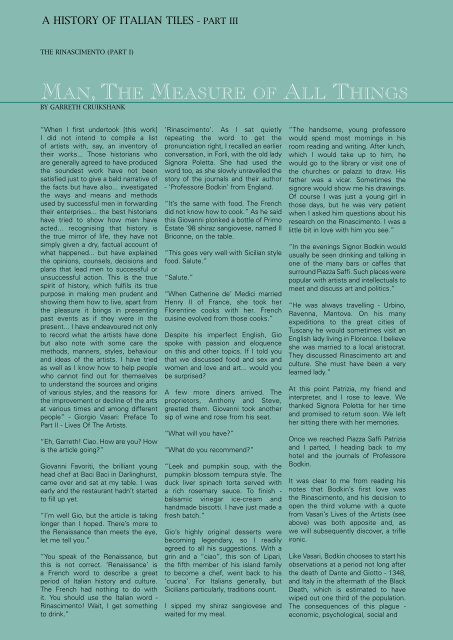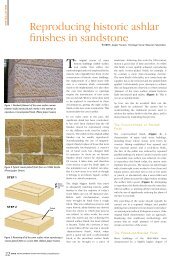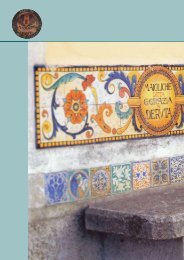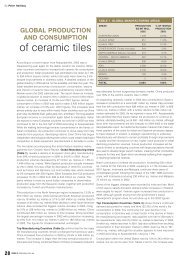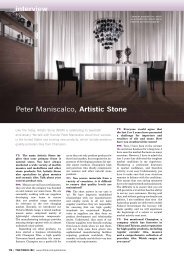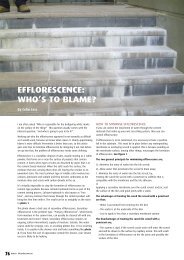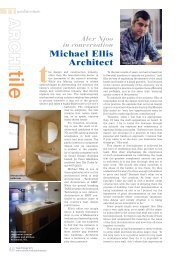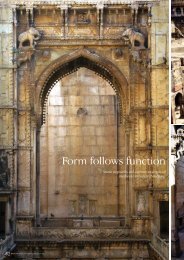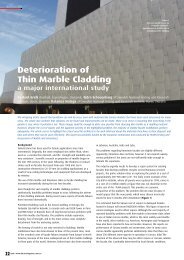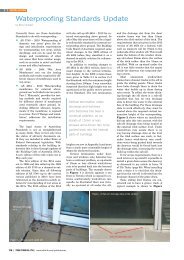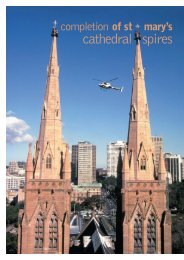A history of Italian tiles - Infotile
A history of Italian tiles - Infotile
A history of Italian tiles - Infotile
You also want an ePaper? Increase the reach of your titles
YUMPU automatically turns print PDFs into web optimized ePapers that Google loves.
A History <strong>of</strong> <strong>Italian</strong> Tiles - Part III<br />
The Rinascimento (Part I)<br />
Man, The Measure <strong>of</strong> All Things<br />
By Garreth Cruikshank<br />
“When I first undertook [this work]<br />
I did not intend to compile a list<br />
<strong>of</strong> artists with, say, an inventory <strong>of</strong><br />
their works... Those historians who<br />
are generally agreed to have produced<br />
the soundest work have not been<br />
satisfied just to give a bald narrative <strong>of</strong><br />
the facts but have also... investigated<br />
the ways and means and methods<br />
used by successful men in forwarding<br />
their enterprises... the best historians<br />
have tried to show how men have<br />
acted... recognising that <strong>history</strong> is<br />
the true mirror <strong>of</strong> life, they have not<br />
simply given a dry, factual account <strong>of</strong><br />
what happened... but have explained<br />
the opinions, counsels, decisions and<br />
plans that lead men to successful or<br />
unsuccessful action. This is the true<br />
spirit <strong>of</strong> <strong>history</strong>, which fulfils its true<br />
purpose in making men prudent and<br />
showing them how to live, apart from<br />
the pleasure it brings in presenting<br />
past events as if they were in the<br />
present... I have endeavoured not only<br />
to record what the artists have done<br />
but also note with some care the<br />
methods, manners, styles, behaviour<br />
and ideas <strong>of</strong> the artists. I have tried<br />
as well as I know how to help people<br />
who cannot find out for themselves<br />
to understand the sources and origins<br />
<strong>of</strong> various styles, and the reasons for<br />
the improvement or decline <strong>of</strong> the arts<br />
at various times and among different<br />
people” - Giorgio Vasari: Preface To<br />
Part II - Lives Of The Artists.<br />
“Eh, Garreth! Ciao. How are you How<br />
is the article going”<br />
Giovanni Favoriti, the brilliant young<br />
head chef at Baci Baci in Darlinghurst,<br />
came over and sat at my table. I was<br />
early and the restaurant hadn’t started<br />
to fill up yet.<br />
“I’m well Gio, but the article is taking<br />
longer than I hoped. There’s more to<br />
the Renaissance than meets the eye,<br />
let me tell you.”<br />
“You speak <strong>of</strong> the Renaissance, but<br />
this is not correct. ‘Renaissance’ is<br />
a French word to describe a great<br />
period <strong>of</strong> <strong>Italian</strong> <strong>history</strong> and culture.<br />
The French had nothing to do with<br />
it. You should use the <strong>Italian</strong> word -<br />
Rinascimento! Wait, I get something<br />
to drink.”<br />
‘Rinascimento’. As I sat quietly<br />
repeating the word to get the<br />
pronunciation right, I recalled an earlier<br />
conversation, in Forli, with the old lady<br />
Signora Poletta. She had used the<br />
word too, as she slowly unravelled the<br />
story <strong>of</strong> the journals and their author<br />
- ‘Pr<strong>of</strong>essore Bodkin’ from England.<br />
“It’s the same with food. The French<br />
did not know how to cook.” As he said<br />
this Giovanni plonked a bottle <strong>of</strong> Primo<br />
Estate ‘98 shiraz sangiovese, named Il<br />
Briconne, on the table.<br />
“This goes very well with Sicilian style<br />
food. Salute.”<br />
“Salute.”<br />
“When Catherine de’ Medici married<br />
Henry II <strong>of</strong> France, she took her<br />
Florentine cooks with her. French<br />
cuisine evolved from those cooks.”<br />
Despite his imperfect English, Gio<br />
spoke with passion and eloquence<br />
on this and other topics. If I told you<br />
that we discussed food and sex and<br />
women and love and art... would you<br />
be surprised<br />
A few more diners arrived. The<br />
proprietors, Anthony and Steve,<br />
greeted them. Giovanni took another<br />
sip <strong>of</strong> wine and rose from his seat.<br />
“What will you have”<br />
“What do you recommend”<br />
“Leek and pumpkin soup, with the<br />
pumpkin blossom tempura style. The<br />
duck liver spinach torta served with<br />
a rich rosemary sauce. To finish -<br />
balsamic vinegar ice-cream and<br />
handmade biscotti. I have just made a<br />
fresh batch.”<br />
Gio’s highly original desserts were<br />
becoming legendary, so I readily<br />
agreed to all his suggestions. With a<br />
grin and a “ciao”, this son <strong>of</strong> Lipari,<br />
the fifth member <strong>of</strong> his island family<br />
to become a chef, went back to his<br />
‘cucina’. For <strong>Italian</strong>s generally, but<br />
Sicilians particularly, traditions count.<br />
I sipped my shiraz sangiovese and<br />
waited for my meal.<br />
“The handsome, young pr<strong>of</strong>essore<br />
would spend most mornings in his<br />
room reading and writing. After lunch,<br />
which I would take up to him, he<br />
would go to the library or visit one <strong>of</strong><br />
the churches or palazzi to draw. His<br />
father was a vicar. Sometimes the<br />
signore would show me his drawings.<br />
Of course I was just a young girl in<br />
those days, but he was very patient<br />
when I asked him questions about his<br />
research on the Rinascimento. I was a<br />
little bit in love with him you see.”<br />
“In the evenings Signor Bodkin would<br />
usually be seen drinking and talking in<br />
one <strong>of</strong> the many bars or caffes that<br />
surround Piazza Saffi. Such places were<br />
popular with artists and intellectuals to<br />
meet and discuss art and politics.”<br />
“He was always travelling - Urbino,<br />
Ravenna, Mantova. On his many<br />
expeditions to the great cities <strong>of</strong><br />
Tuscany he would sometimes visit an<br />
English lady living in Florence. I believe<br />
she was married to a local aristocrat.<br />
They discussed Rinascimento art and<br />
culture. She must have been a very<br />
learned lady.”<br />
At this point Patrizia, my friend and<br />
interpreter, and I rose to leave. We<br />
thanked Signora Poletta for her time<br />
and promised to return soon. We left<br />
her sitting there with her memories.<br />
Once we reached Piazza Saffi Patrizia<br />
and I parted, I heading back to my<br />
hotel and the journals <strong>of</strong> Pr<strong>of</strong>essore<br />
Bodkin.<br />
It was clear to me from reading his<br />
notes that Bodkin’s first love was<br />
the Rinascimento, and his decision to<br />
open the third volume with a quote<br />
from Vasari’s Lives <strong>of</strong> the Artists (see<br />
above) was both apposite and, as<br />
we will subsequently discover, a trifle<br />
ironic.<br />
Like Vasari, Bodkin chooses to start his<br />
observations at a period not long after<br />
the death <strong>of</strong> Dante and Giotto - 1348,<br />
and Italy in the aftermath <strong>of</strong> the Black<br />
Death, which is estimated to have<br />
wiped out one third <strong>of</strong> the population.<br />
The consequences <strong>of</strong> this plague -<br />
economic, psychological, social and


